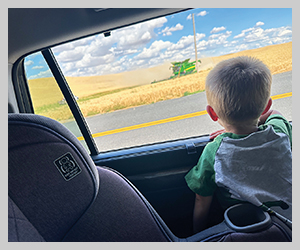Keeping farmers’ lights on at a lower cost David Funk, Zero Emissions Northwest
2024March 2024
By Trista Crossley
Editor

David Funk, president of Zero Emissions Northwest, wants to shine light on ways farmers can reduce their on-farm energy costs and reliance on traditional forms of fuel.
“Zero Emissions Northwest is all about helping farmers access grants from the U.S. Department of Agriculture (USDA) and from other sources to help their farms save money on energy costs,” he explained. “In addition to grants, we also deploy what I call practical energy solutions, which have very short payback periods and impact the bottom line. Everything I do saves the farmer money.”
USDA’s Rural Energy for America Program (REAP), which is partially funded with Inflation Reduction Act (IRA) money, is currently offering reimbursable, matching grants of up to 50% for rural businesses and ag producers who make energy efficiency improvements, such as lighting upgrades, insulation, drones, or renewable energy investments, in their operations. Switching to solar panels to power a shop, for instance, looks extremely attractive, when one adds a tax credit of up to 30% and accelerated tax depreciation to the REAP grant.
“Right now, there are a few utilities that service wheat growers, charging approximately $.07 per kilowatt hour. If 80% of your energy is coming from sunshine, it means your blended energy cost is $.01 a kilowatt hour,” Funk said. “To me, the biggest impact to a farm is not only solar, but what you choose to invest in after solar. It’s not happening immediately, but if your water heater goes out and you’ve been running on propane, maybe you get an electric one next. If your car dies or utility vehicle dies and you need a new one, maybe in three years, there are attractive electric options. It’s basically free energy from the sun and allows that farm to continue to invest in efficiency.”
To qualify for the REAP grant, producers have to have at least 50% of their gross income come from agriculture, and the energy usage has to be existing energy usage tied to the farm. Solar is only one of many options, and there is a fair amount of legwork and paperwork that is required. That’s where Funk comes in.

Funk has been involved in renewable energy and the financing of renewable energy for more than 15 years. It was his marriage to the daughter of a Harrington, Wash., farmer that started him down the path towards Zero Emissions Northwest. During the pandemic, Funk and his family moved to Spokane to be closer to his wife’s family. During a visit to the farm, Funk said he was looking at his father-in-law’s shop and realized there was likely some sort of financial incentive available to farmers to help them reduce their energy costs. He did a little research, found the REAP grant, and helped get solar installed on the shop.
“Then a bunch of neighbors came out and asked if I could get them a grant. I was doing this for fun. I was better at paperwork than the farmers, and I enjoy seeing steel in the ground and seeing progress,” he explained. “I don’t sell solar. It just happens to be lucrative for farmers who can stack grants and tax stuff on top of each other. That’s why solar is a screaming deal.”
In summer 2023, Funk contracted with the USDA to market their programs in Washington and Idaho and assist farmers in applying for them. He said very few people seem to be having conversations with farmers about renewables, energy efficiency, and transportation, because energy usage tends to be just one of the costs of doing business for farmers. They have to use the combine to harvest, and the combine needs fuel.
“There’s no magic bullet with energy, but if you can use 5% less here, 5% there, the incremental changes add up. That’s impactful,” Funk said.
Some of the obstacles Funk has run into is the idea that the deals are “too good to be true” and educating farmers (and their accountants) on how to apply the deductions and tax credits.
“This is real, but it’s not going to last. The 50% grants are from the IRA, and then it will go back to the standard 25% grants from the farm bill. Even then, you’d be about 70% covered, so it’s still viable, you’ve just got to do the paperwork, and jump through a few other hurdles.”
Funk is expanding Zero Emissions Northwest with a new project, Solarize WA Ag, that aims to use the combined purchasing power of multiple buyers to drive down the cost of installing solar. So far, he estimates he’s got more than 50 grant-eligible farmers between Spokane and the Tri-Cities who are interested in winning grants and installing solar. He plans to package those customers and let solar companies bid on that business in hopes of getting a lower installation price.
Solar is only one area that Funk looks at when he’s trying to find ways for a farmer to save energy; another area that could be eligible for a grant includes putting insulation into a shop. The first step is generally doing an energy audit to find areas where energy efficiencies could be deployed. The process isn’t quick; for solar, Funk said it can take 12-18 months from the initial grant application to installation and funding reimbursement.
More information is at zeroemissionsnorthwest.com.












